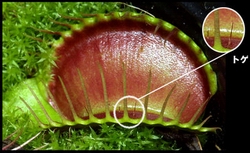Forschung // 28. Januar 2005
How the Venus flytrap snaps
The rapid closure of the Venus flytrap (Dionaea muscipula) leaf in about 100 ms is one of the fastest movements in the plant kingdom. This led Darwin to describe the plant as “one of the most wonderful in the world“. The trap closure is initiated by the mechanical stimulation of trigger hairs. Previous studies have focused on the biochemical response of the trigger hairs to stimuli and quantified the propagation of action potentials in the leaves. Here we complement these studies by considering the post-stimulation mechanical aspects of Venus flytrap closure. Using high-speed video imaging, non-invasive microscopy techniques and a simple theoretical model, we show that the fast closure of the trap results from a snap-buckling instability, the onset of which is controlled actively by the plant. Our study identifies an ingenious solution to scaling up movements in non-muscular engines and provides a general framework for understanding nastic motion in plants.


 Venusfliegenfalle
Venusfliegenfalle